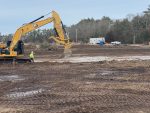Mattapoisett River Reserve wetland restoration continues
It may look like a construction site at the Coalition’s Mattapoisett River Reserve right now, but it’s actually the largest “un-development,” or wetland restoration, project ever undertaken on the Bay.

The above rendering shows what the site will look like once restoration is complete.
Approximately 55 acres of retired cranberry bogs are being transformed back to wildlife-friendly, natural, and functioning freshwater wetlands and grassland habitat. This restoration will allow the land to better absorb and filter water moving into the Mattapoisett River, the harbor and Bay downstream, and the public drinking water supply in the ground underneath.
The restoration project also includes elements that will greatly enhance the visitor experience at the reserve, popular among the Buzzards Bay community for trail walking. The current trail system will be reconfigured and improved, several bridges and boardwalks will be installed throughout the restored site, and the main parking area will be expanded at this popular recreational property.
While trails at the Bogs and Tripps Mill are temporarily closed during construction, visitors are encouraged to explore several other neraby trails, including New Boston Trail, Tinkhamtown Woodlands, and a new trail system and parking area at Red Brick Farm on Long Plain Road in Mattapoisett.

Contractors from Luciano’s Excavation Inc. are hard at work restoring this popular reserve.
The Coalition acquired this property from Decas Cranberry Company following their agreement with the U.S. Department of Agriculture – Natural Resources Conservation Service (USDA-NRCS) to permanently retire the cranberry bogs and to restore natural wetlands on the property. The project will restore approximately 43 acres of freshwater wetlands, benefitting natural vegetation and habitats, improve fish and wildlife movement up and down Tripps Mill Brook (a tributary of the Mattapoisett River), improve nesting habitat for turtles, birds, and other wildlife, and restore floodplain connectivity. This ecological restoration project was designed in conjunction with GZA Engineering and partners at the Massachusetts Division of Ecological Restoration (MA DER) and USDA-NRCS. Construction is being led by Luciano’s Excavation, Inc. of Taunton, MA.
Funding for the restoration project has been made possible by the USDA-NRCS, MA Division of Ecological Restoration (DER), MA Department of Conservation & Recreation’s Recreational Trails Program, and the Massachusetts Environmental Trust.

Once the restoration is complete, visitors will experinece improved trail systems, expanded parking, and more as pictured in the above rendering.